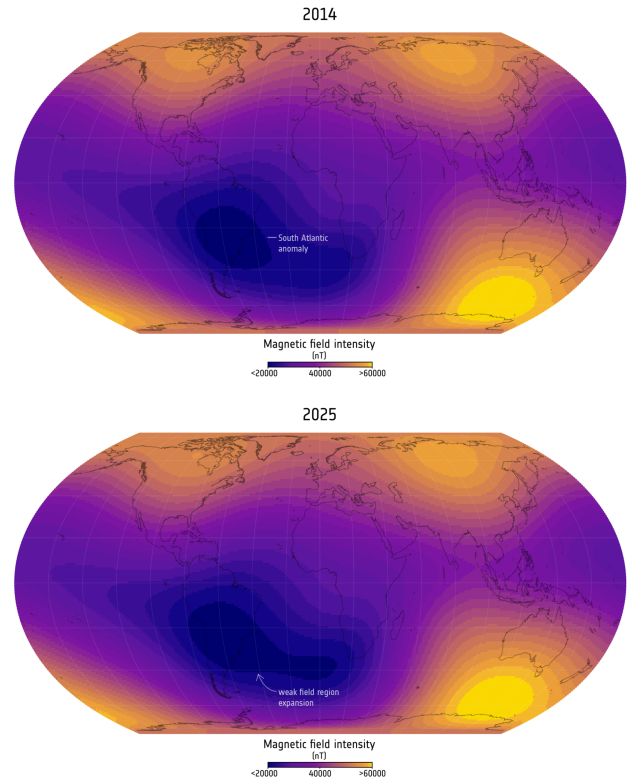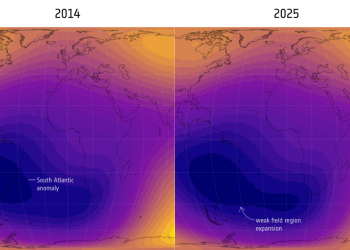A giant gap in Earth’s magnetic field continues to expand, according to the latest data from a trio of satellites monitoring our world.
It’s called the South Atlantic Anomaly, which extends across the gulf that separates Africa from South America, and the latest data suggests it has expanded by about half the size of continental Europe since 2014, while its magnetic intensity weakens.
The measurements indicate that the ocean of molten iron in Earth’s outer core, which generates the planetary magnetic field, is not stable and calm but complex and turbulent, with behavior that can alter the external field on timescales as short as years.
Related: NASA observes vast growing anomaly in Earth’s magnetic field
frameborder=”0″allow=”accelerometer; autoplay; write to clipboard; encrypted media; gyroscope; picture in picture; web sharing” referrerpolicy=”strict-origin-when-cross-origin”allowfullscreen>
The Earth’s magnetic field is a vast network of magnetic field lines generated by the planet’s core dynamo: the rotating, conductive, convective fluid in the outer core that converts kinetic energy into magnetic energy. It extends into space, forming an invisible structure around our planet that helps trap the atmosphere and keep cosmic rays out.
Over the eons, the strength of the magnetic field has fluctuated, even reversing completely into complete polar reversals. These events pose no direct danger to life on the surface, but there are other reasons to study them.
Some navigation systems rely, for example, on the earth’s magnetic field. The magnetic field also deflects charged particles; a weaker magnetic field makes satellites more vulnerable to the accumulation of dangerous charges.
Additionally, the magnetic field deflects solar and cosmic radiation, so astronauts and people flying at high altitudes are exposed to higher radiation doses where the magnetic field is weaker.
Understanding changes in the magnetic field can reveal what’s happening deep within our planet, which, in turn, could help scientists build better predictive models of future behavior to mitigate these problems.

The size and strength of the anomaly in 2014 (top) and 2025 (bottom). (ESA) The South Atlantic Anomaly, or SAA, has been known since at least the 1960s, but it was not the subject of detailed, ongoing study until the launch of ESA’s Swarm mission in 2013 – three satellites designed to work together to map the geomagnetic field.
The latest results from the Swarm mission represent the longest continuous monitoring of Earth’s magnetic field to date, revealing new complexities for SAA.
“The South Atlantic anomaly is not just one block,” explains geophysicist Chris Finlay of the Technical University of Denmark. “The situation is developing differently towards Africa and towards South America. Something special is happening in this region which weakens the field more intensely.”

Scientists aren’t sure what’s causing this anomaly, but they do know that the magnetic field inside the planet below this region isn’t behaving as expected. The Earth’s magnetic field is approximately dipolar; the north magnetic pole is where the magnetic field lines dip into the planet, and the south magnetic pole is where they emerge.
This is a very simplified version; the magnetic field as a whole is a bit more complicated, but overall this model describes how the field is supposed to behave. At the SAA, part of the magnetic flux beneath the Earth’s surface is curiously reversed.
“Normally, we would expect to see magnetic field lines coming out of the core in the Southern Hemisphere. But under the South Atlantic anomaly, we see unexpected areas where the magnetic field, instead of going out of the core, returns to it,” says Finlay.
“With the Swarm data, we can see one of these areas moving westward over Africa, which contributes to the weakening of the South Atlantic anomaly in this region.”
This reversal of magnetic flux could be linked to a large and mysterious mass of extremely hot material located outside the Earth’s core, known as the Large African Low Shear Velocity Province (LLSVP) in the SAA.

frameborder=”0″allow=”accelerometer; autoplay; write to clipboard; encrypted media; gyroscope; picture in picture; web sharing” referrerpolicy=”strict-origin-when-cross-origin”allowfullscreen>
This drop could disrupt the convection of the core, which in turn would modify the behavior of the magnetic field above it. This is believed to be normal behavior on Earth; until recently, we simply didn’t have the tools to study it.
Other changes observed by Swarm in the Earth’s magnetic field include a slight weakening over Canada and a slight strengthening over Siberia, linked to a changing magnetic structure beneath North America.
“It’s really wonderful to get an overview of our dynamic Earth thanks to the extended Swarm time series,” says Anja Stromme, ESA’s Swarm mission manager. “The satellites are all healthy and providing excellent data, so we hope to be able to extend this record beyond 2030, when the solar minimum will provide unprecedented information about our planet.”
The research was published in Earth physics and planetary interiors.









